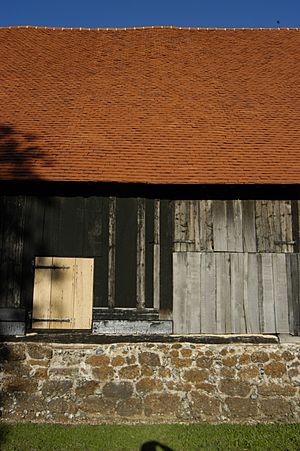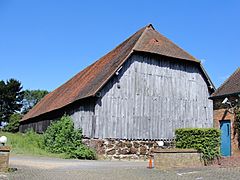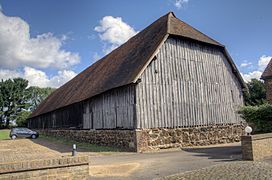Harmondsworth Great Barn facts for kids
Quick facts for kids Harmondsworth Great Barn |
|
|---|---|

The Great Barn in Harmondsworth
|
|
| General information | |
| Architectural style | Medieval |
| Location | Harmondsworth |
| Town or city | Greater London |
| Country | England |
| Coordinates | 51°29′23″N 0°28′48″W / 51.4897°N 0.4799°W |
| Completed | 15th century |
| Client | William of Wykeham, Bishop of Winchester |
The Harmondsworth Great Barn (also called Manor Farm Barn) is a huge, very old barn. It's located in the village of Harmondsworth, near Heathrow Airport in England. This amazing building was built in the early 1400s. It was made by Winchester College, a famous school.
The barn is the biggest building in England made mostly of wood. It's a fantastic example of medieval carpentry, which is the art of working with wood. A famous English poet, John Betjeman, even called it the "Cathedral of Middlesex."
For a short time, the barn belonged to the royal family. But for hundreds of years, it was used by different families for farming. They used it right up until the 1970s! Later, a company bought the farm. When that company ran into trouble, the barn was bought by people hoping to make money if Heathrow Airport expanded.
Sadly, the barn started to fall apart. It was closed to visitors most of the time. But then, English Heritage, a group that protects old buildings, stepped in. They used a special legal process to fix the barn. In 2012, English Heritage bought it. Now, the barn is open to everyone. Volunteers from the Friends of the Great Barn group help manage it.
Contents
What Makes the Barn Special?
The Harmondsworth Great Barn is super long, about 58 meters (192 feet). It's also 11 meters (37 feet) wide and 12 meters (39 feet) tall. Imagine a building with twelve sections, called bays, running from north to south. It's as big as about 7110 square feet inside!
On the east side, there are three large doors. These were used for wagons to enter. The outside of the barn is covered with wooden boards. It has a sloped, tiled roof.
The barn used to be even bigger. It had two extra parts, like wings. But one wing was taken down in 1774. It was rebuilt in a nearby village that no longer exists. Most of the barn you see today is original. About 95% of the wood, even the outside boards, is from the 1400s! English Heritage calls it "a masterpiece of carpentry."
How Was It Built?
This barn is a top example of a medieval "aisled" barn. This means it has rows of posts inside, like the aisles in a church. It's the biggest timber-framed building in England.
Barns like this are very long and tall. This means they need to be strong against the wind. So, they have many wooden braces inside. These braces act like supports, similar to the buttresses on a cathedral. This is why the inside of the barn looks so amazing. It has a criss-cross pattern of beams and braces holding up the roof. The building methods were similar to those used for grand cathedrals back then. It's possible some of the same skilled workers helped build both!
The main posts of the barn are made from strong oak wood. Each post is about 35 centimeters (14 inches) square. They sit on blocks of sandstone, a common building material in medieval London. The builders shaped the wood using axes, special tools called adzes, and saws. You can still see the marks from these tools on some of the wood.
The builders cut and fit the wooden pieces together on the ground first. They scratched Roman numerals, called "assembly marks," on the joints. These marks showed where each piece of wood belonged. Some of the main posts were made from huge tree trunks cut in half. They were placed upside down! This is because the bottom of a tree is wider. The wider part was needed to connect to the roof beams.
Sometimes, builders made mistakes. Some timbers have holes for pegs that were never used. Or, maybe some wood was reused from another building.
The rows of posts inside support strong "tie beams." Curved braces make the frame even stronger. The "collar beam" supports the roof rafters. This beam is held up by a "crown post." Other beams, called "purlins," run along the length of the barn. They are joined into the main rafters. Curved "wind braces" give even more support. Some parts of this design are quite unusual. English Heritage says many features are "experimental" and show a very high level of skill.
Threshing Floors
The "aisles" in the barn helped make it wider. This gave more space for "threshing floors." Threshing was how farmers separated grain from the rest of the plant. The longer the barn, the more threshing floors it could have. Most English barns had just one central threshing floor. But the Harmondsworth Great Barn is special because it has three! This meant much more grain could be threshed at once.
Roof and Floor
The outside boards of the barn are made from oak, elm, and softer woods like pine. Some parts are newer. For example, the boards on the south end are lighter. These were replaced after a fire in 1972.
The barn's roof has about 76,000 tiles! They were originally held in place by oak pegs. Many tiles have been replaced over the years. Now, galvanized nails hold them because the old pegs decayed.
The floor was first made of hard-packed flint gravel. This gravel was dug up locally. Later, the floor was repaired with brick, tile, and cement. This covered up how it originally looked. But you can still see how it might have looked on the outside of the west side.
Inspiring Architects
The design of this barn has inspired many architects. In the 1800s and 1900s, architects working in the Gothic Revival style looked to it. For example, Sir George Gilbert Scott visited the barn in 1850. He sketched it and used its design for plans for a new cathedral in New Zealand. The library at Mansfield College, Oxford and the library at Bedales School also got ideas from the barn's design.
A Look Back in Time
Before the Norman Conquest in 1066, King Harold Godwinson owned the land where the barn stands. But after Harold died, William the Conqueror took it. In 1391, the land was bought by William of Wykeham, the Bishop of Winchester. He gave it to Winchester College, which he had founded. The money earned from the land helped support the college.
There was already a "Great Barn" here. Records from as early as 1110 show that workers had to "thresh in the Great Barn." In 1398, a storm damaged the old barn. Winchester College sent carpenters to fix it. But the old barn wasn't big enough anymore.
So, in 1426–27, the college hired two men to get wood for a new barn. Scientists have used a method called dendrochronology (studying tree rings) to confirm the wood is from the early 1400s. We don't know the exact architect. But it might have been William Wyse. He was a main carpenter for other big buildings like New College, Oxford and Windsor Castle. Once finished, the barn was used to thresh and store grain from the farm.
In 1544, King Henry VIII took the land for his hunting estate. But he didn't use it much. Soon after, he gave it to the Paget family. They owned it until 1869. Later, the Ashby family owned it. The last Ashby farmer died in 1948.
The barn was recognized as a special historic site in 1950. It continued to be used for farming until the 1970s. It had a few close calls! During World War II, a German bomb landed nearby. It flattened another barn but only knocked a few tiles off the Great Barn's roof. In 1972, a fire badly damaged the south end, but it was fixed.
Falling Apart and Being Saved
In 1986, a company bought the barn and the farm. They wanted to fix up the barn and use it to show off their work. They built new offices, hoping the money from them would pay for barn repairs. But in 2006, the company went out of business. The other buildings were sold, but the barn couldn't be sold easily.
Hillingdon Council and English Heritage were offered the barn for just £1, but they said no. Instead, a company from Gibraltar bought it. This company had no other assets. It was reported that they hoped to get a lot of money if Heathrow Airport expanded and needed the land. Even though the barn was just outside the planned runway area, its future was uncertain. The new owners didn't take care of the barn. It started to fall apart and was mostly closed to the public.
- Neglect and repair: 2009–2012
In 2009, a magazine called Cornerstone warned everyone about the barn's bad condition. They reported many holes in the roof and plants growing on the old stone base. English Heritage said the owner wasn't talking to them.
So, English Heritage took legal action. In November 2009, they did emergency repairs on the barn without the owner's permission. This was allowed under a special "Urgent Works Notice." They even changed the barn's legal status to speed things up. The repairs fixed holes in the roof and stopped rain from getting in. They also fixed the wooden boards on the sides.
This led to a big argument over the £30,000 cost of the repairs. But in January 2012, they reached an agreement. The company sold the barn to English Heritage for £20,000. By then, the government had stopped plans to expand Heathrow Airport. The barn was no longer a good investment for the company.
Simon Thurley, the head of English Heritage, called the barn "one of the greatest medieval buildings in Britain." He said it was built by the same skilled carpenters who built cathedrals. The local MP, John McDonnell, was very happy. He praised everyone who helped save the building for future generations.
Open to Visitors
Today, the Harmondsworth Great Barn is looked after by volunteers. They are part of a group called the Friends of the Great Barn at Harmondsworth. They work with English Heritage, who owns the barn. It's free to visit! You can go on the second and fourth Sunday of each month, from April to October.






